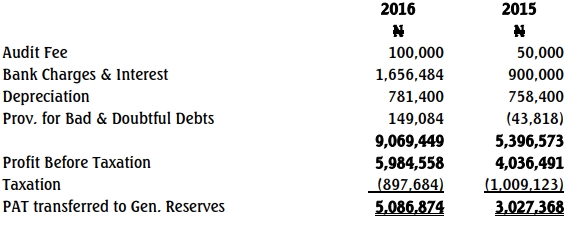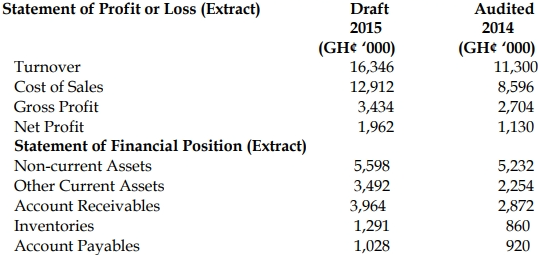As the Senior Audit Manager in MNO & Co, a firm of Chartered Accountants, you have
just had a meeting with a Senior Partner at the firm, in which he informed you that you
have to carry out an investigation requested by the Management of ECO Ltd.
i) One of ECO Ltd’s subsidiaries, PQR Ltd, has been making losses for the past year. ECO Ltd’s management is concerned about the accuracy of PQR’s most recent quarter’s management accounts. The summarised statements of profit or loss for the last three quarters are as follows:
|
Quarter to 31-Mar 2018
GH¢’000 |
Quarter to 31-Dec 2017
GH¢’000 |
Quarter to 30-Sep 2017
GH¢’000 |
| Revenue |
429 |
334 |
343 |
| Opening inventory |
180 |
163 |
203 |
| Materials |
318 |
251 |
200 |
| Direct wages |
62 |
54 |
74 |
|
560 |
468 |
477 |
| Less closing inventory |
(162) |
(180) |
(163) |
| Cost of goods sold |
398 |
288 |
314 |
| Gross profit |
31 |
46 |
29 |
| Less overheads |
(63) |
(75) |
(82) |
| Net loss |
(32) |
(29) |
(53) |
| Gross profit (%) |
7.2% |
13.8% |
8.5% |
| Materials (% of revenue) |
78.3% |
70.1% |
70.0% |
| Labour (% of revenue) |
14.5% |
16.2% |
21.6% |
ii) ECO Ltd’s management board believes that the high material consumption as a percentage of revenue for the quarter to 31 March 2018 is due to one or more of the following factors:
- Under-counting or under-valuation of closing inventory
- Excessive consumption or wastage of materials
- Material being stolen by employees or other individuals
iii) PQR Ltd has a small number of large customers and manufactures its products to each customer’s specification. The selling price of the product is determined by:
- Estimating the cost of materials;
- Estimating the labour cost; and
- Adding a mark-up to cover overheads and provide a normal profit.
iv) The estimated costs are not compared with actual costs. Although it is possible to analyse purchase invoices for materials between customers’ orders, this analysis has not been done.
v) A physical inventory count is carried out at the end of each quarter. Items of inventory are entered on inventory sheets and valued manually. The company does not maintain perpetual inventory records and a full physical count is to be carried out at the financial year end, 30 June 2018.
vi) The direct labour cost included in the inventory valuation is small and should be assumed to be constant at the end of each quarter.
vii) Historically, the cost of materials consumed has been about 70% of revenue. The management accounts to 31 March 2018 are to be assumed to be correct.
Required:
a) Identify and describe the matters that you should consider and the procedures you should carry out in order to plan an investigation of PQR Ltd.’s losses. (10 marks)
b) Explain the matters you should consider to determine whether closing inventory at 31 March 2018 is undervalued. (3 marks)
c) Describe the tests you should plan to perform to quantify the amount of any undervaluation. (3 marks)
d) Identify and explain the possible reasons for the apparent high materials consumption in the quarter ended 31 March 2018. (2 marks)
e) Describe the tests you should plan to perform to determine whether materials consumption, as shown in the management accounts, is correct. (2 marks)
(Total: 20 marks)




